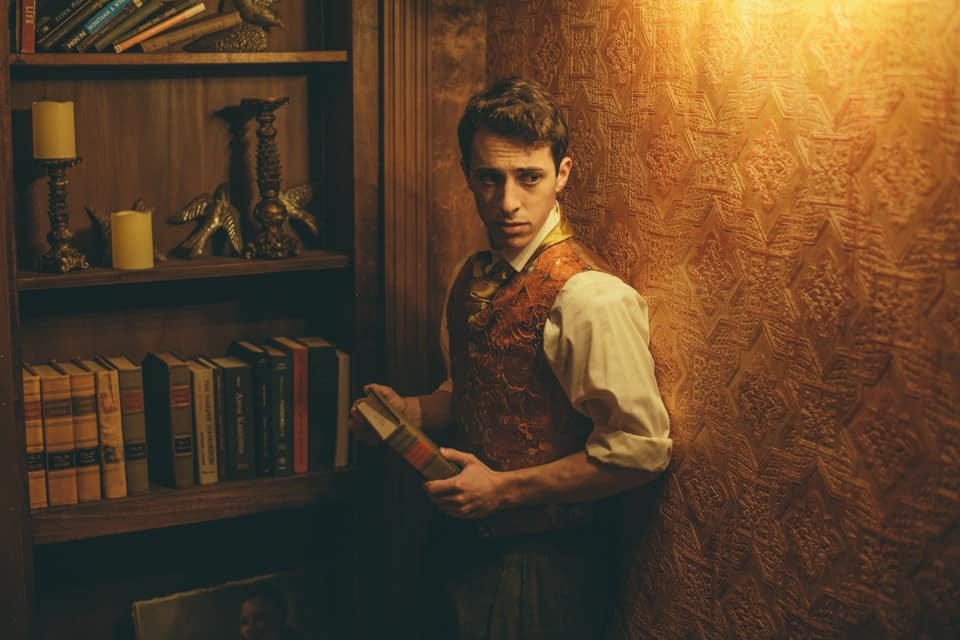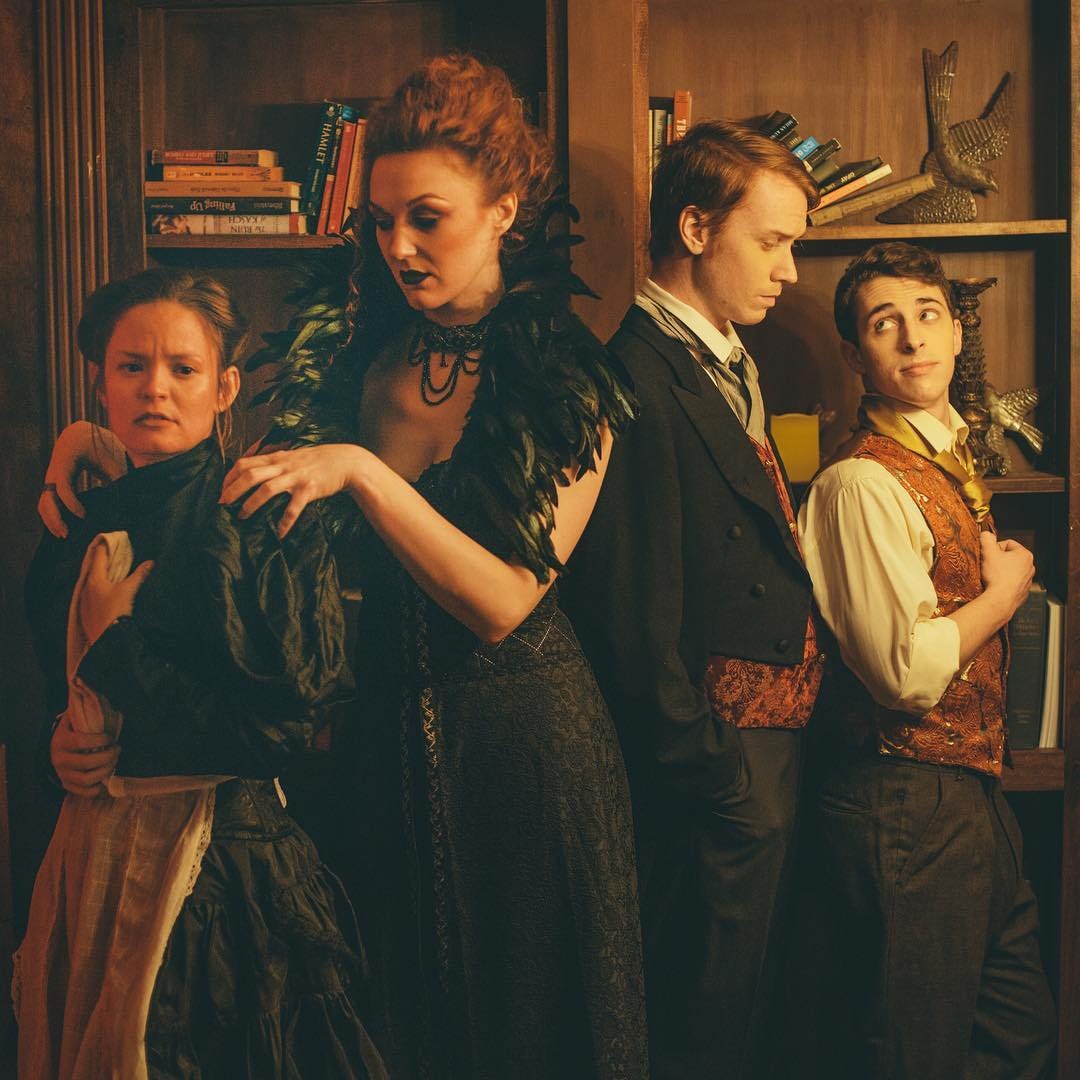
A new immersive show flaps its wings in Manhattan
There’s a visitor who’s come to Galloway Manor. And he’s here to stay, for good, we think. But we’re simply… the help. We’ve come to assist poor lonely Ember (Annelise Nielsen), who has served as the single maid here for years. She’s lived at the Manor her entire life and it’s a lot of house for one person to maintain, particularly under the eye of the intimidating Lady Viola Galloway (Alicia Buxton).

We, the new servants, are assigned places to stand and given aprons to wear, in fitting with our new jobs. We stand when we’re told to stand. We sit when we’re told to sit. We follow when asked; we always close the door behind us; we only speak when spoken to; we don’t open closed or locked doors. The rules of Galloway Manor are quite clear. And as far as immersive on-boarding goes, it’s one of the better approaches to “casting the audience” I’ve seen.
The group of 12 is quickly split into four separate groups and storylines. I’m one of three who follow Lady Viola as she traipses about, strong-arming Ember, her son Damian Galloway (Colin Hinckley), as well as her newly-arrived godson Victor (Justin Chesney). She threatens all of them in her own way: Ember about her crush on Damian, Damian about a horrifying secret in his past, and Victor about his special relationship with Damian. She also tortures herself, poring over letters from her dead husband William. (There’s a lot going on.) And despite having only five rooms to work with, the “manor” feels sufficiently lived-in and interesting, filled with books, flowers, herbs, potions, and keepsakes.
This world has some other inconsistencies, though. On occasion, a disembodied voice interrupts the original classical music that plays during the piece. It’s unclear whether these are a character’s inner thoughts or perhaps the ghosts they’re haunted by. I think I recognize Ember’s voice, but only hers. It’s distracting and the effect comes off as a overly melodramatic and cheesy when the production appears to be going for a cinematic feel the rest of the time.
There are also intermittent dance scenes which seem out of place. Are the characters only dancing when they are possessed or being emotionally manipulated by Lady Viola? I struggled with the internal logic. Ember seems to dance only when the lights are flickering, but why? The performers sometimes flip from text to dance and back to text again so quickly it feels jarring.
As we walk amongst the rooms of the Manor, we receive confirmation that Viola is indeed some variety of witch. Her robe even makes a strong allusion to Maleficent. But it’s hard to say whether she is just a witch, going mad from trauma, or both. It’s an tough role to play, to be both tragic and dangerous at the same time, and I can almost feel the character’s weight pressing down upon the performer. I also wanted her to berate us, the servants, but the character doesn’t seem fully committed to being the villain of the piece.
(Spoilers follow.)
Viola’s motives for keeping Damian locked away at home are also unclear for a good third of the show, until the drama quickly gets turned up to 11 during a violent argument (warning: actual broken glass, domestic abuse). Suddenly, half the audience gets pulled into a climactic scene involving a series of shocking revelations. Did William assault Viola? Was William murdered? Were Victor’s parents also murdered? And by whom? The narrative touches upon these areas briefly but doesn’t return to them, rushing instead to the next thing. And then with the snap of a finger, multiple plot lines converge. The build up feels rough and uneven. Rather than an emotional rollercoaster, Through The Wren takes us into a sudden drop as the bottom falls out from under us (content warning: murder, suicide) and the audience is given an unsolvable puzzle at one moment.
Get Kathryn Yu’s stories in your inbox
Join Medium for free to get updates from this writer.
SubscribeSubscribe
And the coda to the piece, done in complete darkness, goes on for several minutes too long, as the ghosts of the dead whisper to us and enact flashlight-lit tableaux. These scenes tell us a great about their relationships when they were still alive, but it’s all information I would have loved to have seen in context, half an hour previous.

With newer immersive companies, the tendency can be to rush from scene to scene, as opposed to giving the work (and audience) space to breathe. Otherwise we can end up with immersive whiplash through constant traversal. And there needs to be space for improvisational moments to happen. For example, the night I attended the show, one participant accidentally kicked some glass bottles in Viola’s study. She quickly snapped at him that the liquor bottles were empty, and he needn’t bother — a wonderful response in the moment.
And despite being billed as a queer Gothic romance, I didn’t actually get to see much of the two lovers. My track following Viola rarely coincided with both Victor and Damian at the same time. This is a trend I’ve seen recently with immersive works: anchoring the audience against a single character in a non-looping story gives them an emotional connection to the story, but can be unsatisfying. A viewing experience tied solely to one point of view often cannot provide a fulfilling story arc. Some characters’ journeys end up stronger and more interesting than others. And in smaller capacity shows, executed in small quarters, there aren’t enough group scenes to fill in the knowledge gaps. (It can be tempting to say that the viewer should simply return and visit another character’s track but this unfairly puts the onus on the participant, both in terms of the opportunity cost and financial cost; plus, you may end up on the same track again, by coincidence.)

Fans of Wildrence will enjoy seeing how the lovely rooms of the storytelling studio have been adapted to fit the story and ways the sync-ed sound and lighting work together throughout the space. There are some lovely design touches throughout. But I’m curious to see how Through the Wren might evolve in the future with some significant editing and design changes. There’s a grab bag of ideas here that never quite gel. I’d love to see better pacing, more character development, and a more effective buildup to the narrative’s intended catharsis, as well as a way to explore more than one character’s perspective. The experience feels incomplete without all audience members getting more exposure to both Damian and Victor’s stories.
Until then, this little bird needs to spend more time in the nest.
Through the Wren continues at Wildrence through October 14. Tickets are $80.
NoPro is a labor of love made possible by:

…and our generous Patreon backers: join them today!
In addition to the No Proscenium web site, our podcast, and our newsletters, you can find NoPro on Twitter, Facebook, YouTube, Instagram, in the Facebook community Everything Immersive, and on our Slack forum.















Discussion